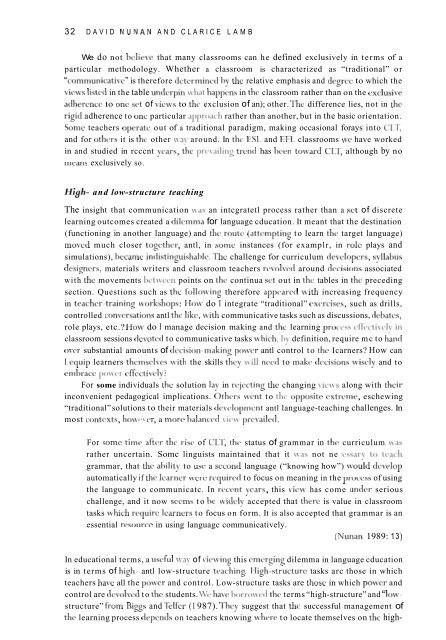Download - Search
Download - Search
Download - Search
You also want an ePaper? Increase the reach of your titles
YUMPU automatically turns print PDFs into web optimized ePapers that Google loves.
32 DAVID NUNAN AND CLARICE LAMBWe do not Ilclievc that many classrooms can he defined exclusively in terms of aparticular methodology. Whether a classroom is characterized as “traditional” or“communicativc” is therefore determined by the relative emphasis and degrcc to which theviews listed in the table underpin \\.hat happens in the classroom rather than on the cxclusiwadherencc to one set of views to thc exclusion of an); other. Thc difference lies, not in therigid adherence to onc particular ap[iroach rather than another, but in the basic orientation.Somc teachers operatc out of a traditional paradigm, making occasional forays into CL2T,and for others it is the other \.ray around. In the ESI. and EFIJ classrooms vvc have workedin and studied in rcccnt !cars, the Ix-cvailing t rcd has hcrn to\vard CLT, although by nomeans exclusively so.High- and low-structure teachingThe insight that communication \vas an intcgratetl process rather than a set of discretelearning outcomes created a dilcmma for language cducation. It meant that the destination(functioning in another language) and thc routc (attcmpting to learn thc target language)moved much closer togethcr, antl, in some instances (for examplr, in role plays andsimulations), became indistinguisha1,lc.. The challenge for curriculum devclopcrs, syllahusdesigners, materials writers and classroom teachers revolved around decisions associatedwith thc movements 1,ctween points on the continua set out in the tables in the precedingsection. Questions such as the follo\ving therefore appeared Ivith increasing frequencyin teacher-training kvorkshops: Ho\v do I integrate “traditional” excrcises, such as drills,controlled conversations antl the like, Lvith communicative tasks such as discussions, tlebatcs,role plays, etc.? Ho\v do I manage decision making and the learning proclassroom sessions devoted to communicative tasks Lvhich, by definition, require mc to handover substantial amounts of tlccision-making pvcr antl control to the Icarners? How canI equip learners thcmselvcs \vith the skills thcy \vi11 nccd to makc tlccisions \viscly and toembrace po\vcr cffccti\-ely?For some individuals the solution la? in wjccting the changing vie\vs along with theirinconvenient pedagogical implications. Others lvcnt to the oppositc extreme, eschewing“traditional” solutions to their materials clcvelopmcnt antl language-teaching challenges. Inmost contcxts, hou cr, a more Iialanccd \icw prcvailctl.For some time after thc rise of CL‘I; thc status of grammar in the curriculum \vasrather uncertain. Somc linguists maintained that it \vas not negrammar, that the abilit? to LISC a second language (“knowing how”) \vould developautomatically if the learner \vcrc required to focus on meaning in the proccss of usingthe language to communicatc. In rcccnt ?cars, this vicw has come under seriouschallenge, and it now seems to 1~ widely accepted that there is value in classroomtasks kvhich require lcarncrs to focus on form. It is also accepted that grammar is anessential resource in using languagc communicatively.(Nunan 1989: 13)In educational terms, a useful \.ray of viewing this emerging dilemma in language cducationis in terms of high- antl low-structure tcaching. Iligh-structure tasks arc those in whichteachers have all the pvcr and control. Low-structure tasks are those in which power andcontrol are devolved to the students. We have borrowd the terms “high-structure” and “lowstructure”from Biggs and Telfcr (1 987). They suggest that the successful management ofthc, learning process depcntls on teachers knowing kvhere to locate themselves on the high-


